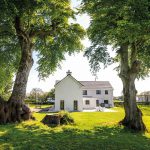Building a house to your own design and specification is the dream for many people. But like all ideals, it can be difficult to achieve. Individual building sites are not easy to find and you must work that bit harder to secure a good one.
Finding the right site to build your house on can be difficult. It’s a process that isn’t recommended for the timid; some people tell stories about searching for years and this is true for many, especially if you’re particular about views, privacy, the need for extra land and all the other variables.
It’s not that sites aren’t available, the problem is accepting one that is less than your dream. You may also have to revise your thoughts about the type of house you want to build. If what estate agents say is true about location, location, location, then the approach most likely to succeed is one that begins with finding the site, and it’s only then that the design can be brought into play. Flexibility, combined with the ability to focus your time and energy on the hunt, will give you the best chance of success.
Types of site
A greenfield site refers to land that’s not been built on before – whether in open countryside, gaps in rural areas, on the outskirts of villages or between existing houses. Brownfield sites as defined by NI Planning Service, are those ‘in the built-up areas of settlements that have potential for development, and that includes previously developed land, undeveloped land and vacant buildings’.
It’s important to note that by definition, a brownfield site is not heavily contaminated, otherwise it would not be considered for development. If you suspect soil contamination on your site you’ll have to get it professionally assessed to see if it is safe to build on. Samples will be taken and a course of action recommended.
Disused land and brownfield sites are very easy to miss. It takes a lot of imagination to see a telephone exchange, a disused industrial unit, or a scrap yard as the site for a beautiful home, but they all could be, subject to planning approval. Technology has also helped with the development of mini piling systems and tanking for example, both of which could make a problem site viable.
[adrotate banner="58"]Building on agricultural land is a possibility but many areas in ROI have qualifying conditions. Some counties will require you to have spent a substantial period of your life living in the area, referring to farmers, their sons, daughters and/or anyone taking over the ownership and running of the family farm.
If your background isn’t farming, then sons and daughters of non-farming persons who have spent at least five years living in the area and wish to build within 5km (3 miles) of the family residence will be considered. Returning emigrants who had spent at least five years living in the area in which they propose to build can also apply to build on agricultural land. These can include those wishing to reside near other family members, carers for elderly immediate family members, working locally or retiring.
In NI high quality agricultural land is viewed as an important resource so the planners favour maintaining compact settlements, directing development to areas of poorer agricultural quality land and encouraging the re-use of redundant or derelict land. As obtaining planning permission for a greenfield site in an open area is therefore difficult, these sites are rare.
To find out if a site is viable, it’s important to check your council’s Development Plan and any Local Area Plan for the locality, in particular for policies restricting/permitting development in certain areas. These might include greenbelt, coastal areas, rural housing control zones etc. You should also keep an eye out for maps covering Scenic Amenity, Natural Heritage Areas (NHA), Special Protection Areas (SPA), Special Areas of Conservation (SAC) and Areas of Geological Interest.
Archaeology policies relating to the site you have in mind should also be noted. If your site falls within any of these areas, you should take advice from the Council Planning Department before proceeding to purchase.
In Northern Ireland, a new building in the countryside will only be acceptable if it:
Blends sympathetically with landform, uses existing trees, buildings, slopes or other natural features to provide a backdrop, is an identifiable site with long established boundaries separating the site naturally from the surrounding ground and it does not spoil any scenic aspect or detract from the visual appearance of the countryside.
Buying an existing house and demolishing it is another option which does tend to put the cost up. You may think that planning permission is more likely, but beware of trying to replace it with either a taller or larger dwelling, or not exactly on the footprint of the original; all the normal caveats of planning permission in your area still apply.
Neither does buying an existing dwelling guarantee ground ready to build on, but the fact that a building is there does mean it is less likely than with a greenfield that the ground will be poor. Also, the ‘good’ ground may only lie exactly where the house was built and if your design is wider than that you still could face expensive foundations.
If the building is Listed (NI) or a Protected Structure (ROI) there are separate and strict guidelines about what you may and may not do. Planning permission is needed for work carried out that would materially affect its structure so you may not be free to create the design you wish. If in doubt, write to your local authority (ROI) for a declaration under Section 57 of the Planning and Development Act 2000 about the structure and its curtilage (land and outbuildings immediately surrounding a structure which is (or was) used for the purposes of the structure).
This declaration states what types of work can be carried out without affecting the character of the structure, and in addition, the normal rules on planning permission apply. The declaration will be available to you within 12 weeks of receiving a request, there is no fee. If you disagree with the declaration you can appeal to An Bord Pleanála.
In NI consent will normally only be granted for extensions or alterations to a Listed building when all the following criteria are met:
- The essential character of the building and its setting are retained and its features of special interest remain intact and unimpaired.
- The works proposed make use of traditional and/or sympathetic building materials and techniques which match or are in keeping with those found on the building
- The architectural details (e.g. doors, gutters, windows) match or are in keeping with the building.
Many listed buildings can tolerate some degree of thoughtful alteration or extension so may work as a site if the situation is what you are looking for. It’s a case of weighing up if you will be allowed to do enough to the building to create the type of home you had envisaged constructing from scratch. Always bear in mind that what appears insignificant alterations to you may not be the view of the Council and Department of the Environment.
Finding your site
Unfortunately there is no single route to follow here, and Lady Luck plays her part as well! The wider the area the greater the choice – but you also run the risk of overlooking something. Make no mistake, site hunting is hard work and with the advent of the internet, there are even more avenues to explore. You may think some are a little far-fetched but in the search for your perfect site don’t rule anything out.
Registering your interest with estate and land agents (especially independents) in the area you’re keen on remains an effective approach. Get in touch with local surveyors and architects too, as they’ll find out about new sites early. The internet is a good hunting ground as well as it’s where you’ll find private sales in addition to full listings from some, but not all, estate agents.
Newspapers both national and local are worth exploring but the cost of a print advertisement compared to an online listing means many properties may only appear once, if at all. Exploring the area on foot or driving around slowly gives you time to spot a For Sale sign now buried in a hedge, see laneways and visit local shops, pub, post office and newsagent all of which can provide vital information. You can leave an address and contact number or put an advertisement yourself in their window.
Knocking on doors can produce mixed responses, some people are keen to help, others view it as an invasion of their privacy, but if you don’t ask you don’t get as the saying goes. A less overt approach is to write to the householders and/or their neighbours. The owners of large gardens may not have realised their potential as a building site for example. Keep an eye on planning applications for outline approval especially as this indicates a site but not one with the design for a house, and therefore a purchase possibility for you.
Finally, and this is especially useful in rural areas, an OS map will show tracks and roads you may not be aware of. If all else fails, chartering a light plane to cover the area you want to build in to spot possible locations not easily seen from the ground may sound far-fetched, but it could make the difference between success and failure. Mark potential sites on a map to follow up later.
Property finders
It’s not just the rich and famous who use a Property Finder to find them a house to renovate or a site to build on. Given the amount of emotional capital and financial outlay involved in building, it’s a small price to pay for that perfect spot.
If you are time poor or live some distance away from where you want to build, then they are well worth consideration. With local knowledge and experience they are able to root out ones that don’t meet your criteria and perhaps hear about sites on offer privately and not in the public domain, known as ‘off market’.
There is no formal qualification for being a property finder although many have a background in estate agency or estate management, but being interested in people and experience in the property market in general are essential.
They are not all surveyors although good agencies will insist on staff having a background in this or a professional qualification, and it is helpful if they have a database of professionals such as surveyors who you may need to call upon to establish the viability of a site or house. Be wary of estate agents who describe themselves as being property finders as well as surveyors because you can’t do the first two and be impartial, whilst the third is a specialist task, especially with older properties.
A property finder will give you invaluable advice on the best street in a residential area, proximity to amenities and even help you to see the potential in a home that requires some up-dating. A good property finder will also ensure that you pay no more than market value in relation to current trends.
A retention fee (which depends on the price range but will be in the region of €250 – 1,500/£200 – £1,200 plus VAT), will be charged which is normally for an initial search over about three months.
If nothing is found, you can let it rest for some months and then try again, or pay a retainer to be notified of potential properties but without engaging the full service. That way you won’t miss anything although a good property finder, who will normally also expect a success fee, will notify you anyway.
The fees cover contacting all possible sources and driving around your chosen area for places that have not been advertised but are the subject of local knowledge. Potential properties will be viewed, photographed, notes taken and, preferably, the vendors interviewed. The purpose of this is to discover background information which could be of critical importance, and they will be more willing to give this to a property finder who they know has an interested client.
All this information is then sent to you by email if possible, for speed, and viewings arranged. More sophisticated agencies have a content management system where clients have a user login that allows them to keep track of what their property finder is doing, and to view all the information and photographs gathered to date.
Plot potential
Large gaps between and behind houses – it’s usually easier to get planning approval for development in between, or next to, an existing house. If there is space beside a house, or a large back or side garden with vehicular access, it is a potential site. Beware though of ‘ribbon development’ on the outskirts of villages which planners will not allow, currently the aim is to have clusters of habitation.
Remember also that planners are unlikely to look favourably on a design that is out of step with the surrounding houses and if that is your primary reason for building, choose an area that is appropriate for your plans. From a purely economic perspective, the way houses are valued means that it is less economic to build a house that is massively disproportionate to those surrounding it.
You can end up over-developing, that is spending far more money on a house than you could ever sell it for; or under-developing, that is building too small a house and failing to realise the full potential of the site. On a practical note, bring a camera to record what you have seen and details of where it/they are.
Plot pitfalls
A ransom strip is the name given to small – it could be a matter of less than a metre – area of land belonging to someone other than the vendor of the site but which, in order to build, you will need to either purchase outright or pay an amount to use. Never rely on a handshake or word of mouth agreement, you must have a legally binding document.
Restricted covenants are more often found in suburban rather than rural situations, particularly where there was a large house whose demesne has been gradually built on. They tend to cover such things as the position of windows, where you can have access from, boundary hedges, ridge heights etc. Ideally you want to be able to have the covenant removed, but that is not always certain and it may also be time consuming and expensive.
Another unforeseen expense is the cost of connection to mains services such as water and electricity; connection to the main sewer in a suburban situation is usually relatively straightforward.
Distance is the main problem with the first two, the further you are away from a connection the more expensive it becomes. In rural areas, if you are planning to use a soakaway system for waste water you will need to ensure your land is suitable; few people will allow you to use theirs or discharge into a watercourse on their land.
A more recent addition to this list is the presence of radon gas. Dealing with this is straightforward and you won’t be able to test for it until the house is built, but if this is a concern, check out the level in the area.
All sites, whether rural or suburban, will be covered by the zoning and planning policies set out by the local council and available to view at their offices. It’s time well spent studying these to check if the type of house you want to build and the site you have chosen are likely to be acceptable to the council.
Legal issues
There is only so much you can do ‘on the ground’ to find out if the site is suitable and worth the asking price. If all your questions have received the right answers the next step is to engage a solicitor who will make all the necessary checks over ownership, boundaries – in fact everything affecting the title and your ability to build and live there.
This is crunch time as it is sometimes only when you get into the finer detail do you discover, for example, that access is shared by a local pig breeder or that planning permission has been passed for a factory at the foot of the lane.
Finding the right site is, for most people, hard work and time consuming. Given the investment you are about to make in the build, that cost and effort, as you will discover, is valuable experience for the next part!
Site hunting websites
Additional information
David Donaldson, Donaldson Planning, Co Down BT18 9AE tel. 9042 3320 www.donaldsonplanning.com
Mark D Stephens, Architect, Co Mayo tel. (0) 85 159 4084 www.markstephensarchitects.com
www.ahg.gov.ie/en/heritage A Guide to Protected Buildings
www.epa.ie/radiation and www.ukradon.org/information/ukmaps/northernireland
www.planningni.gov.uk for NI www.environ.ie for ROI and also www.gov.ie/services/search-planning-applications-in-your-local-authority
Article by Gillian Corry and Catherine Doran



